Gipfeli Recipe
Follow this simple Gipfeli recipe for a delicious taste of Switzerland with every bite of these perfectly baked croissants.
- Prep Time: 1 hour
- Cook Time: 20 minutes
- Total Time: 1 hour 20 minutes
- Yield: 12
- Category: Breakfast
- Method: Baking
- Cuisine: Swiss
Ingredients
All-Purpose Flour (500g): Provides structure while keeping the pastry tender. Sifting ensures a smooth, airy dough.
Warm Milk (250ml): Activates the yeast and adds richness. Keep it at 35-40°C (95-105°F) to avoid killing the yeast.
Sugar (50g): Aids fermentation and adds a subtle sweetness without overpowering the buttery flavor.
Active Dry Yeast (7g): Creates air pockets for a light, airy pastry. Ensure freshness for the best rise.
Salt (1 Tsp): Enhances flavor and strengthens gluten for a well-structured dough.
Cold Unsalted Butter (250g, Small Pieces): Essential for flaky layers. Keep it cold to ensure proper lamination.
Beaten Egg (1): Brushed on top for a glossy, golden finish.
Instructions
In a tiny bowl, mix the yeast with warm milk. Stir lightly and allow it to rest for around 5 minutes. Stir gently and let it sit for about 5 minutes. You should see a frothy layer forming on top of the milk. This is the sign that the yeast is active and ready to work its magic in the dough.

In a spacious mixing bowl, blend together the flour, sugar, and salt. Give them a quick stir to evenly distribute the ingredients. Next, create a well in the center by pushing the flour to the edges. This will allow you to pour in the yeast mixture without splashing it everywhere.
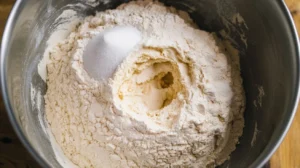
Carefully pour the frothy yeast and milk mixture into the well of dry ingredients. Use a wooden spoon or your hands to mix everything together until it forms a dough. At first, it may seem a little sticky, but don’t worry—this will smooth out during the kneading process.
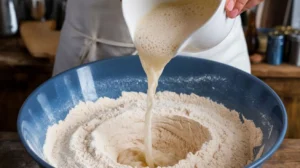
Turn the dough out onto a lightly floured surface and knead it for about 10 minutes. Press down with the heel of your hand and fold the dough over itself, stretching it as you go. This helps develop the gluten, which gives Gipfeli its light, airy texture. After about 10 minutes, the dough should feel smooth and elastic.
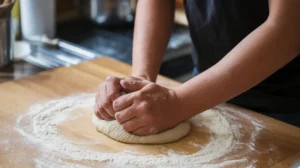
Place the kneaded dough into a greased bowl. Cover it with a clean cloth and leave it in a warm, draft-free spot for about 1 hour. The dough should double in size during this time, as the yeast works its magic, creating air pockets.
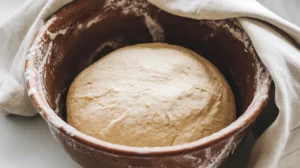
After the dough has doubled in size, move it onto a surface dusted with flour. Roll it out into a large rectangle, making sure to keep the edges even. This will make the lamination process easier and more uniform.
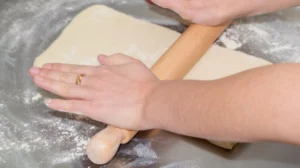
Take small, cold pieces of butter and distribute them evenly over one half of the dough. The butter must be cold to ensure the perfect layers. Once the butter is evenly spread, fold the other half of the dough over it and press down on the edges to seal the butter inside.
Roll out the dough into a large rectangle again, keeping it as even as possible. Then, fold it into thirds like a letter—this is where the magic of layers begins! Repeat the rolling and folding process two more times to build up the delicate, flaky layers that Gipfeli is known for.
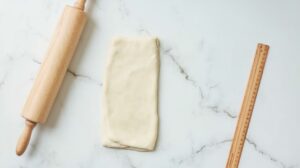
Wrap the dough tightly in plastic wrap and place it in the fridge for at least 1 hour. This chilling step is crucial because it keeps the butter solid, ensuring it remains within the dough during the next rolling steps.
After chilling, roll the dough out one final time into a large rectangle. Use a sharp knife or pastry cutter to slice the dough into triangles. The base of each triangle should be wide enough to easily roll it into a crescent shape.

Starting from the wide base of each triangle, gently roll the dough towards the point. Be sure to roll lightly so the layers don’t get flattened. Place the shaped Gipfeli on a baking sheet lined with parchment paper, leaving space between each one to allow for expansion.
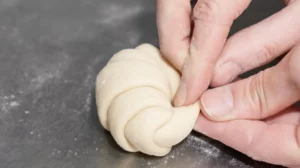
Cover the rolled Gipfeli with a damp kitchen cloth and allow them to rise for another 30 minutes. Meanwhile, preheat your oven to 200°C (400°F). Once the Gipfeli have risen, brush each one lightly with a beaten egg using a pastry brush to give them a golden, glossy finish.
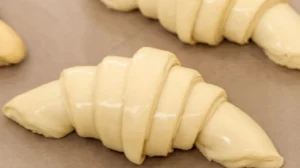
Place the Gipfeli in the oven and bake for 15-20 minutes, or until they turn a rich golden brown and puff up beautifully. The smell of freshly baked pastries will fill your kitchen, and you’ll know they’re ready when they have a crisp, golden exterior.
If you want to take your Gipfeli to the next level, consider adding a filling of your choice. You can stuff them with a tangy yuzu curd or a sweet strawberry jam—whatever suits your taste. Slice open each Gipfeli, add your filling, and enjoy the heavenly layers inside.
Notes
Cold Butter is Essential
Keep the butter cold to ensure flaky layers. Refrigerated butter helps create the delicate, airy texture Gipfeli is known for.
Warm Milk for Yeast Activation
Use warm milk (not hot) to activate the yeast. The ideal temperature is 35°C to 40°C (95°F to 105°F), which helps the dough rise perfectly.
Flour the Surface
Lightly dust your work surface with flour before kneading to prevent sticking. Avoid using too much to keep the dough moist and smooth.
Roll Gently and Evenly
Apply gentle, even pressure when rolling out the dough. Let it rest if it resists, ensuring consistent thickness and layers.
Shape with Care
Roll the dough from the wide end to the pointy tip for a perfect crescent shape. Press the tip lightly to seal, keeping the layers intact.
Nutrition
- Serving Size: 12 Gipfeli
- Calories: 300 kcal
- Sugar: 2g
- Sodium: 304mg
- Fat: 13g
- Saturated Fat: 7g
- Carbohydrates: 16g
- Fiber: 1g
- Protein: 3g
- Cholesterol: 46mg
Find it online: https://yummycookin.com/gipfeli-recipe/
